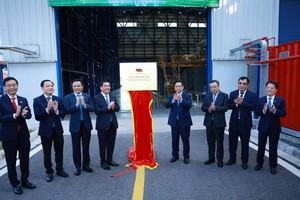 Corals cultured in a protected area can grow well when brought to the outside environment. (Photo: SGGP)
Corals cultured in a protected area can grow well when brought to the outside environment. (Photo: SGGP)
Accordingly, Van San Dao JSC was assigned 28 hectares in the coastal waters of Tien Beach in Vinh Hoa Ward of Nha Trang City by Khanh Hoa Province to conserve, restore, and develop biodiversity, as well as protect marine ecosystems, with an investment of about VND14.7 billion, funded by the company itself.
This is also one of the projects that the Ministry of Natural Resources and Environment approved the environmental impact assessment report in March 2022.
According to the document, the artificial reef to restore coral reefs covers an area of about 1.9 hectares of land under the seabed, with a depth of 4-4.5 meters. Artificial reefs are installed from prefabricated concrete on the shore and natural rocks but are ensured not to contain harmful substances to aquatic species and be sustainable in the marine environment.
For the operation phase, the investor applies coral nurturing techniques, ensuring environmental conditions to maintain the restoration and development of corals. At the same time, they monitor the stability of coral nurseries and artificial reefs and protect seawater quality to limit the development of harmful organisms to corals.
In addition, after being handed over the field sea area, the investor will place landmarks with zoning buoys to limit outside influences on the marine ecosystem and waterway traffic activities; coordinate with local authorities to prevent acts of harming the ecosystem in Nha Trang Bay; comply with the regulations on protecting the ecosystem and biodiversity and prohibit the act of hunting marine creatures.
Accordingly, since 2019, the company has cooperated with a group of experts from Nha Trang Oceanographic Institute to pilot and test. The project tested coral resilience with two species of the Acropora genus, including Acropora muricata and Acropora robusta.
This is also one of the projects that the Ministry of Natural Resources and Environment approved the environmental impact assessment report in March 2022.
According to the document, the artificial reef to restore coral reefs covers an area of about 1.9 hectares of land under the seabed, with a depth of 4-4.5 meters. Artificial reefs are installed from prefabricated concrete on the shore and natural rocks but are ensured not to contain harmful substances to aquatic species and be sustainable in the marine environment.
For the operation phase, the investor applies coral nurturing techniques, ensuring environmental conditions to maintain the restoration and development of corals. At the same time, they monitor the stability of coral nurseries and artificial reefs and protect seawater quality to limit the development of harmful organisms to corals.
In addition, after being handed over the field sea area, the investor will place landmarks with zoning buoys to limit outside influences on the marine ecosystem and waterway traffic activities; coordinate with local authorities to prevent acts of harming the ecosystem in Nha Trang Bay; comply with the regulations on protecting the ecosystem and biodiversity and prohibit the act of hunting marine creatures.
Accordingly, since 2019, the company has cooperated with a group of experts from Nha Trang Oceanographic Institute to pilot and test. The project tested coral resilience with two species of the Acropora genus, including Acropora muricata and Acropora robusta.
 After the pilot period, many coral branches have developed positively in Nha Trang Bay. (Photo: SGGP)
After the pilot period, many coral branches have developed positively in Nha Trang Bay. (Photo: SGGP)
The biodiversity restoration project has achieved positive results, with dozens of coral branches of the Acropora genus growing healthily. Accordingly, there are a total of about 770 coral groups on the nursery frame and the natural bottom. Of which, 424 species of Acropora robusta and 346 species of Acropora muricata have been used. After nine months of restoration, the percentage of live corals was above 61 percent, with the percentage of live corals on the nursery frame higher. The corals under the project reach a growth rate of 11.6 millimeters per month. This is a good sign of the progress of coral development. Previously, the SGGP newspaper reported that corals in the Hon Mun Island area of Nha Trang Bay were bleached in mass. The bottom of the sea is devastated and dilapidated, and there are no longer scenes of fish and marine life that are as rich and diverse as before. This makes many scuba divers, locals, and tourists regretful. Facing the above situation, Khanh Hoa Provincial Party Committee has directed the Provincial People's Committee to have a substantive assessment of the status of the conservation work of coral reefs to identify the cause. At the same time, the province must propose solutions to handle, overcome, and compel completion in the report and send it to the Standing Provincial Party Committee before June 19.
























